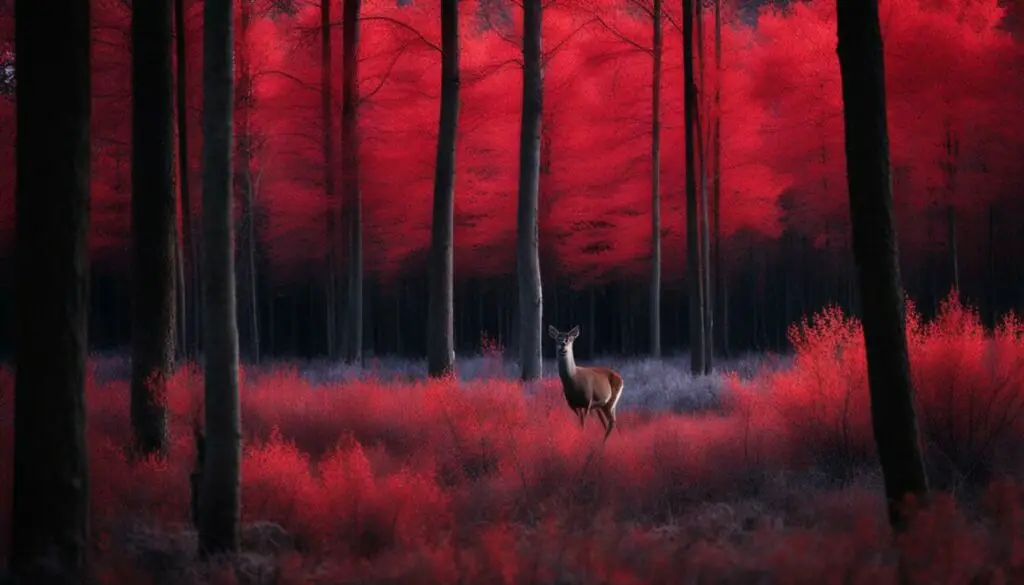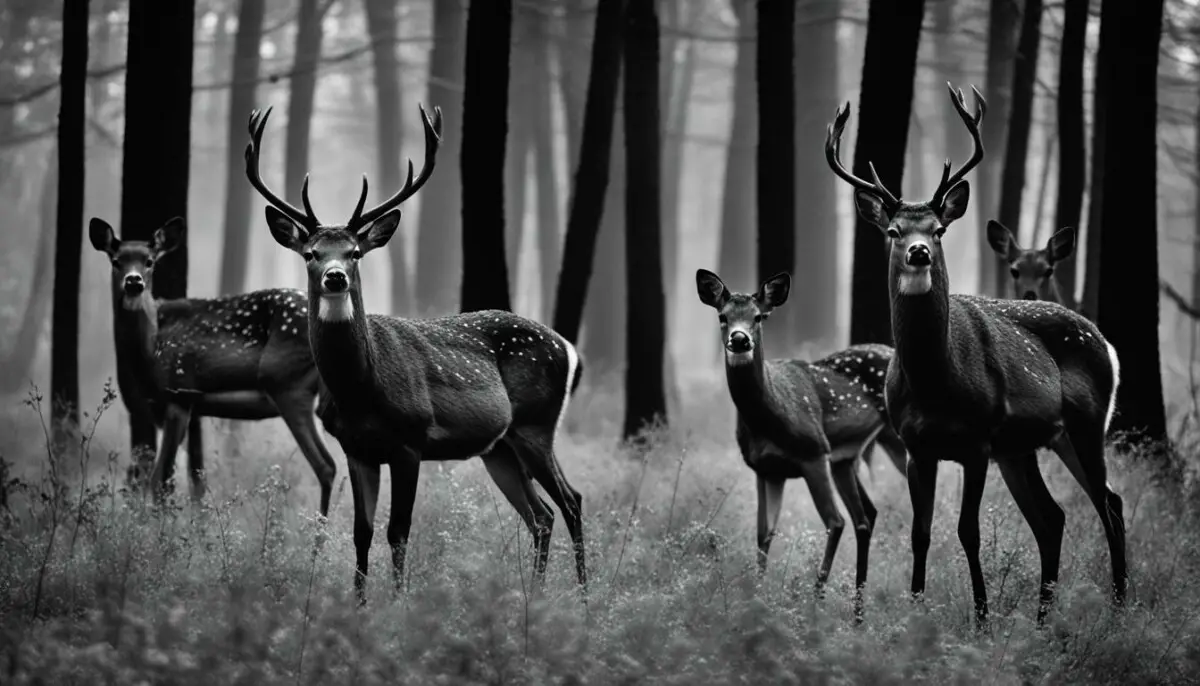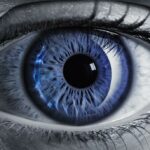Last Updated on 5 months by Francis
Deer are known for their keen sense of eyesight and their ability to sense predators and potential threats from a distance. However, there is a lingering question about whether deer can see infrared flash. Understanding the capabilities of deer vision when it comes to detecting infrared light can have implications for hunting strategies and the use of trail cameras. Let’s explore the science behind deer vision and shed light on this intriguing mystery.
Contents
Key Takeaways:
- Deer have a wide visual field and can see almost all the way around themselves without turning their heads.
- Deer have dichromatic vision and can only see short blue and long green wavelengths.
- Deer cannot see infrared light as their eyes are not designed to detect longer wavelengths.
- Deer can sense infrared radiation through specialized thermoreceptor cells, allowing them to detect heat signatures.
- The presence of infrared flash from trail cameras is unlikely to startle deer, as they cannot perceive the infrared light being emitted.
The Science Behind Deer Vision
Deer have a highly developed sense of eyesight that allows them to spot predators and potential threats. Their visual field is wider than that of humans, providing them with a 310-degree view angle. This means they can see almost all the way around themselves without turning their heads. However, when it comes to detecting details and colors, deer are not as proficient as humans.
Deer have dichromatic vision, which means they can only see short blue wavelengths and long green wavelengths. They are unable to see red, yellow, or orange wavelengths that are important for detecting ripe fruits and berries. But what about infrared light?
Research suggests that deer do not have the ability to see infrared light. Their eyes are not designed to detect wavelengths longer than 720 nm, which is within the visible light spectrum. This means that they cannot see into the infrared spectrum and are unable to detect heat signatures or objects that are emitting infrared radiation. So, while deer may have impressive eyesight, they are not able to perceive infrared light.
The Ability of Deer to Detect Infrared Light
Deer, with their sharp eyesight, are renowned for their ability to spot predators and potential threats from a distance. However, when it comes to detecting infrared light, their vision falls short. Research suggests that deer do not have the ability to see infrared light, as their eyes are not designed to detect wavelengths longer than 720 nm, which is within the visible light spectrum. This means that deer cannot see into the infrared spectrum and are therefore unable to detect heat signatures or objects that emit infrared radiation.
While deer may not be able to see infrared light, they can still sense it using their other senses. Deer have specialized cells called thermoreceptors that are capable of detecting changes in temperature. When an object emits infrared radiation, it also emits heat energy, which the thermoreceptors in a deer’s body can sense. This ability allows deer to detect heat signatures from a distance, aiding in the identification of potential threats and prey.
These findings have significant implications, particularly for hunting strategies and the use of trail cameras. Hunters using trail cameras with infrared flash can rest assured that the presence of these devices is unlikely to startle deer or affect their behavior, as deer cannot perceive the infrared light being emitted. Additionally, researchers studying deer behavior must consider the limitations of deer eyesight when designing experiments, as visual cues that are visible to humans may be invisible to deer.
| Key Points | Implications |
|---|---|
| Deer cannot see infrared light, as their eyes are not designed to detect wavelengths longer than 720 nm. | Trail cameras with infrared flash are unlikely to startle deer or affect their behavior. |
| Deer can sense infrared light using specialized cells called thermoreceptors. | Researchers studying deer behavior must consider the limitations of deer eyesight when designing experiments. |
“While deer may not be able to see infrared light, they can still sense it using their thermoreceptors. This knowledge can inform hunting strategies and research methods, helping individuals understand the limitations of deer eyesight.” – Wildlife Expert
Understanding the visual capabilities of deer when it comes to infrared flash visibility is crucial for both hunters and researchers. While deer cannot see the infrared light itself, they may be sensitive to the faint glow emitted by some infrared trail cameras. Further research is required to determine the extent of their sensitivity and whether they can detect the faint red glow from low-glow infrared cameras. By gaining a deeper understanding of deer’s ability to detect infrared flash, we can develop more effective strategies for wildlife monitoring and continue to respect the boundaries of these fascinating creatures.
Infrared Flash Detection in Deer: How They Sense the Unseen

While deer cannot see infrared light, they possess remarkable sensory adaptations that allow them to sense its presence. Deer have specialized cells called thermoreceptors, which can detect changes in temperature. When an object emits infrared radiation, it also emits heat energy, which the thermoreceptors in a deer’s body can sense. This enables deer to detect heat signatures from a distance, helping them identify potential threats and prey.
The ability of deer to sense infrared radiation has important implications for hunting strategies and research. Hunters using trail cameras with infrared flash can position their cameras without worrying about startling or affecting the behavior of deer. This knowledge allows hunters to strategically place their cameras and increase the chances of capturing valuable footage. Similarly, researchers studying deer behavior need to consider the limitations of deer eyesight when designing experiments, as visual cues that are visible to humans may be invisible to deer.
To fully understand the extent of a deer’s ability to detect infrared flash, further research is needed. While deer may not be able to see the infrared light itself, they may still be sensitive to the faint glow emitted by some low-glow infrared trail cameras. Ongoing research aims to determine the visibility of infrared flash to deer and provide insights into the visual capabilities of these fascinating creatures.
| Infrared Flash Detection in Deer | Implications |
|---|---|
| Deer cannot see infrared light. | Hunters can strategically position trail cameras without alarming deer. |
| Deer can sense infrared radiation through thermoreceptors. | Research on deer behavior needs to consider their limitations in detecting visual cues. |
| Deer may be sensitive to the faint glow emitted by some low-glow infrared trail cameras. | Ongoing research aims to determine the extent of deer’s ability to detect infrared flash. |
Key Takeaways:
- Deer cannot see infrared light but can sense it through their thermoreceptors.
- Hunters using infrared trail cameras can position them strategically without alarming deer.
- Researchers studying deer behavior need to consider the limitations of deer eyesight.
- Ongoing research aims to determine the visibility of infrared flash to deer.
“While deer may not be able to see the infrared light itself, they possess remarkable sensory adaptations that allow them to sense its presence. This ability to detect infrared radiation through their thermoreceptors provides valuable insights into how deer perceive their environment.” – Wildlife Biologist, Dr. Emily Reynolds
Implications for Hunting and Research

The fact that deer cannot see infrared light has important implications for hunting strategies and research. For hunters using trail cameras with infrared flash, the presence of these devices is unlikely to startle deer or affect their behavior, as deer cannot perceive the infrared light being emitted. This knowledge can help hunters position their trail cameras strategically without the fear of spooking deer.
Similarly, researchers studying deer behavior need to consider the limitations of deer eyesight when designing experiments. Visual cues that are visible to humans may be invisible to deer, and alternative methods of detecting stimuli may need to be employed. By understanding the visual capabilities of deer, researchers can design experiments that accurately reflect how deer perceive their environment.
Furthermore, the knowledge that deer cannot see infrared light raises ethical considerations when using trail cameras for wildlife monitoring. It is important to prioritize the welfare of animals and abide by ethical and legal guidelines. This includes familiarizing oneself with local regulations regarding the use of trail cameras, obtaining necessary permits, and respecting boundaries when placing cameras on private or protected land. Additionally, consideration should be given to the privacy of individuals who may inadvertently appear in the footage captured by trail cameras.
| Implications for Hunting and Research | |
|---|---|
| Implications for Hunting | Implications for Research |
|
|
By taking into account the limitations of deer eyesight and employing ethical practices, we can gain a better understanding of these fascinating creatures and continue to enjoy the wonders of wildlife.
Understanding Deer Eyes and Infrared Flash Visibility

When it comes to deer eyes and the visibility of infrared flash, there are some intriguing factors to consider. While deer cannot see infrared light itself, they may still be sensitive to the faint glow emitted by certain infrared trail cameras. These cameras are designed to minimize the visible light emitted by their LEDs, making them less detectable to deer and other wildlife. However, there is still ongoing debate and no consensus on whether deer can see the faint red glow from low-glow infrared cameras.
Research has shown that deer do not have the ability to see wavelengths longer than 720 nm, which is within the visible light spectrum. This means they are unable to see into the infrared spectrum and cannot detect heat signatures or objects emitting infrared radiation. While they may not be able to see the infrared flash, deer possess specialized cells called thermoreceptors that can detect changes in temperature. These thermoreceptors allow deer to sense the heat produced by infrared radiation, helping them identify potential threats and prey.
It’s important to note that the limitations of deer eyesight and their ability to detect infrared flash have implications for hunting strategies and research methods. Hunters using infrared trail cameras can position them strategically without alarming deer, as the deer cannot perceive the infrared light being emitted. Researchers studying deer behavior must also consider these limitations, ensuring they design experiments that take into account the visual cues that are visible to humans but invisible to deer.
Table: Comparing Deer Eyesight and Infrared Flash Visibility
| Aspect | Deer | Infrared Flash Visibility |
|---|---|---|
| Ability to see infrared light | No | Debate and ongoing research |
| Ability to detect heat signatures | Yes, via thermoreceptors | Debate and ongoing research |
| Impact on hunting strategies | Allows hunters to use infrared trail cameras without alarming deer | Provides an advantage to hunters |
| Implications for research | Researchers need to consider these limitations and design experiments accordingly | Requires alternative methods to study deer behavior |
Overall, while deer cannot see infrared flash, they possess unique sensory abilities that allow them to sense the heat produced by infrared radiation. Further research is needed to fully understand the extent of their ability to detect infrared flash, but this knowledge can already inform hunting strategies and research methodologies. By considering the visual capabilities of deer and adhering to ethical practices, we can continue to deepen our understanding of these fascinating creatures and ensure their welfare in wildlife monitoring efforts.
Ethical Considerations of Using Trail Cameras
When it comes to using trail cameras for wildlife monitoring, it is crucial to consider the ethical implications and adhere to legal guidelines. Respecting the welfare of animals should be a top priority in all wildlife monitoring activities.
Before setting up trail cameras, it is important to familiarize yourself with the local regulations governing their use. Some areas may require permits or have specific rules for where cameras can be placed. Adhering to these regulations ensures that wildlife is not unduly disturbed or harmed.
In addition to legal considerations, it is essential to be respectful of private and protected land boundaries when placing trail cameras. Obtaining permission from landowners and respecting their property rights is crucial. It is also important to consider the privacy of individuals who may inadvertently appear in the footage captured by trail cameras.
“Ethical considerations should always guide our use of trail cameras in order to minimize any negative impact on wildlife and their habitats.”
The Importance of Non-Intrusive Monitoring
Non-intrusive monitoring techniques should be employed to minimize disturbance to wildlife. This includes using trail cameras with low-glow or no-glow infrared flash, which emit minimal visible light. By reducing the visibility of the camera flash, the risk of alarming or altering the behavior of animals is significantly reduced.
Regular maintenance and checking of trail cameras is also important to ensure they are functioning properly and not causing harm to wildlife. It is crucial to avoid situations where animals become habituated to the presence of cameras, as this can disrupt their natural behavior and may result in unintended consequences.
| Table: Ethical Considerations for Using Trail Cameras |
|---|
| 1. Familiarize yourself with local regulations and obtain necessary permits. |
| 2. Respect boundaries and obtain permission when placing cameras on private or protected land. |
| 3. Minimize disturbance by using trail cameras with low-glow or no-glow infrared flash. |
| 4. Regularly maintain and check trail cameras to ensure they are not causing harm to wildlife. |
| 5. Avoid habituating animals to the presence of cameras to preserve their natural behavior. |
Adhering to these ethical considerations ensures that trail cameras can be used as valuable tools in wildlife monitoring while minimizing any negative impacts on the animals and their habitats. By employing responsible practices, we can continue to gain valuable insights into the natural world without compromising the well-being of the wildlife we seek to study and protect.
Can Deer See Infrared Flash?
Deer have long been admired for their sharp eyesight and ability to detect potential threats from a distance. However, there has been ongoing speculation about whether deer can see infrared flash. Understanding the visual capabilities of deer in relation to infrared light is essential for both hunters and researchers who rely on trail cameras. Let’s delve into the science behind deer vision to uncover the truth.
Research suggests that deer do not possess the ability to see infrared light. Their eyes are not designed to detect wavelengths longer than 720 nm, which falls within the visible light spectrum. Therefore, deer cannot perceive infrared flash or heat signatures emitted by objects. However, while deer may lack the ability to visually detect infrared light, they can still sense it using their thermoreceptors.
Deer have specialized thermoreceptor cells that can detect changes in temperature. When an object emits infrared radiation, it also releases heat energy that can be detected by a deer’s thermoreceptors. Though invisible to their eyes, the heat generated by infrared flash can still be sensed by deer, enabling them to identify potential threats and prey.
Knowing that deer cannot see infrared flash has significant implications for hunting strategies and research. Hunters using trail cameras with infrared flash can position their devices strategically without worrying about startling or disturbing deer. Furthermore, researchers studying deer behavior must consider the limitations of deer’s eyesight when designing experiments, ensuring that visual cues are adjusted to accommodate their dichromatic vision.
Additional FAQs
Here are some frequently asked questions regarding deer vision and their ability to perceive light:
Can animals see infrared light?
Most animals cannot see infrared light. However, there are some species, like snakes, that have specialized sensors to detect heat emitted by other animals in the infrared range.
Can deer see ultraviolet light?
Yes, deer can see ultraviolet light. This ability helps them see well in low-light conditions.
Can deer see a flash of a camera?
Deer can see the flash of a camera, although their vision differs from that of humans.
What animal can see ultraviolet and infrared light?
Animals that can see both ultraviolet and infrared light simultaneously are rare. While deer can see ultraviolet light, they are less sensitive to infrared light.
Can deer see infrared trail cameras?
Deer may be sensitive to the faint glow emitted by some infrared trail cameras, but further research is needed to understand the extent of their sensitivity.
At what wavelength does infrared light become invisible to deer?
Deer are not able to see light wavelengths beyond 700 nanometers, which is where the infrared spectrum begins. Infrared light becomes invisible to deer beyond this point.
Do deer have better night vision than humans?
Yes, deer have better night vision than humans. This is due to their higher number of rod cells and their ability to see a wider range of light wavelengths.
Are deer sensitive to particular colors of light?
Deer are more sensitive to certain colors, particularly blue and ultraviolet light.
Does wearing camouflage help humans avoid detection by deer?
Wearing camouflage can help humans avoid detection by deer, as it breaks up the human silhouette and makes it more difficult for deer to spot them.
What is the primary reason deer are sensitive to infrared light?
The primary reason why deer are sensitive to infrared light is still a topic of debate. However, they are known to be more sensitive to ultraviolet light, which could be related to their sensitivity to infrared light as well.
FAQ
Can deer see infrared light?
No, deer cannot see infrared light. Their eyes are not designed to detect wavelengths longer than 720 nm, which is within the visible light spectrum.
How do deer sense infrared radiation?
Deer have specialized cells called thermoreceptors that can detect changes in temperature. When an object emits infrared radiation, it also emits heat energy, which the thermoreceptors in a deer’s body can sense.
Can deer detect infrared flash from trail cameras?
Deer cannot see the infrared light itself, but they may be sensitive to the faint glow emitted by some infrared trail cameras. The extent of their sensitivity is still being researched.
What other animals can see infrared light?
Most animals cannot see infrared light, but some species, such as snakes, have specialized sensors to detect heat emitted by other animals in the infrared range.
Can deer see ultraviolet light?
Yes, deer can see ultraviolet light, which helps them see well in low-light conditions
Can deer see a flash of a camera?
Yes, deer can see the flash of a camera, although their vision differs from humans.
What animals can see both ultraviolet and infrared light simultaneously?
Animals that can see both ultraviolet and infrared light simultaneously are rare. While deer can see ultraviolet light, they are less sensitive to infrared light.
Are deer sensitive to the faint red glow from low-glow infrared cameras?
There is ongoing debate and no consensus on whether deer can see the faint red glow from some low-glow infrared cameras. Further research is needed to understand the extent of their sensitivity.
At what wavelength does infrared light become invisible to deer?
Infrared light becomes invisible to deer at wavelengths beyond 700 nanometers, which is where the infrared spectrum begins.
Do deer have better night vision than humans?
Yes, deer have better night vision than humans due to their higher number of rod cells and their ability to see a wider range of light wavelengths.
Are deer sensitive to particular colors of light?
Deer are more sensitive to certain colors, particularly blue and ultraviolet light.
Does wearing camouflage help humans avoid detection by deer?
Wearing camouflage can help humans avoid detection by deer as it breaks up the human silhouette.
What is the primary reason deer are sensitive to infrared light?
The primary reason deer are sensitive to infrared light is still a topic of debate, but they are more sensitive to ultraviolet light.








